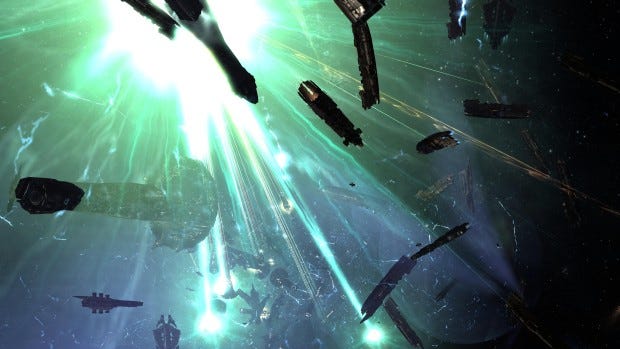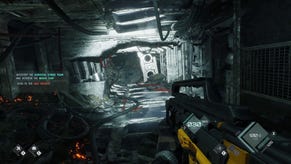Big Trouble In EVE China
The Untold Story Of EVE Online's Biggest Battle
One of EVE Online's most important features is that everything takes place on a single UK-based server called Tranquility. Cool story bro, but the only problem is that's not quite true. The Chinese version of EVE Online has its own server, Serenity, operated by the publisher Tiancity – and it has just as much, if not more, capacity for the enormous player-driven events EVE is known for. Barely two months after all those headlines about B-R5 being 'the biggest / most expensive videogame battle ever,' a 23-hour war in EVE China made that look like a dry run. It was given a simple name: the slaughterhouse.
A brief history lesson about Serenity; EVE Online was launched in China in 2006 and initially operated by the publisher Optic Communication. After a hugely successful opening few months, which saw over a million accounts registered and a simultaneous login peak of just under 39,000 pilots, the game began to tank. Over 2007-2009 Serenity was in relatively dark times, never seeing more than 6,000 players logged in at one time.
When the licensing agreement expired in 2011, CCP decided to go with a new partner; Tiancity. At Fanfest one of the game's producers, Duo Ye, ran through Tiancity's strategy – they started trying to reduce the time between Tranquility's expanions and the launch in China, naming the first in June 2012 'A New Era.' They immediately started to pull the audience back in, setting a new simultaneous user high of 42,000 players, and by the second expansion 'Inferno' saw paying subscriptions double.
But player numbers are one thing. What's really interesting is that Tiancity, at this stage in Serenity's life, thought that things were too quiet. ““It was too calm and we wondered if we'd made an error in judgement,” says Ye. “So this was designed to get people fighting. There were too many ships locked up.”
 (All screenshots by Rooks And Kings. Click to enlarge.)
(All screenshots by Rooks And Kings. Click to enlarge.)
In April 2013 they released the Retribution expansion and in August the Odyssey expansion – these together did things like rebalancing the most common combat ships (frigates, cruisers and destroyers) adding more ships, allowing players to train dual characters (so they could have a 'combat alt'), revamped scanning, and various other minor tweaks.
Soon enough it would bear fruit.
“Fights in Serenity since Retribution have got bigger and more frequent,” says Ye. “Before Retribution it was mostly skirmishes, but afterwards we saw stuff like sovereignity and more life-or-death battles.”
“Before that point there were also less people playing,” says community co-ordinator and senior gamesmaster Ray Zhou. “And basically less people means less war.”
Serenity's great war occurred in the system 49-U6U between two enormous coalitions, and was sparked by a defection. A huge western coalition existed between PIBC, the biggest corporation on Serenity with over 25,000 players, the mercenary group Veni Vidi Vici (usually called '3V'), and the July and Fadeklein alliances.
The PIBC coalition, which stands for Pan-Intergalactic Business Community, is not only the biggest but also the oldest alliance in EVE China. They 'own' most of the north, the west and a big chunk of the centre of Serenity. 3V are in essence an enormous mercenary alliance – think of a PMC. This inclination and PIBC's enormous coffers have led to a meeting of minds. Beyond even this, Serenity's producer Duo Ye pointed out that the leaders of PIBC and 3V both live in the city of Chengdu, and are thought to be IRL buddies.
It seems that EVE is real everywhere.
The dispute began over a region of space known as 'Tribute' – which is basically a chokepoint to the north of Serenity. 3V have had control of this area, under the ultimate sovereignty of PIBC, since 2009. Over Christmas 2013 both FDK and the July alliance attempted to negotiate with PIBC for the region in order to secure a route to some of their more remote territories.
PIBC refused. Not only this, but an audio recording was leaked among the Chinese player community of a PIBC higher-up explaining that Tribute was an effective blockade against these alliances expanding.
Realising they were effectively being throttled over the long-term, things turned nasty and FDK and July Alliance attacked 3V for control of Tribute. Things went well – at first. But almost immediately PIBC began to bolster 3V's forces, and overwhelmingly crushed the two aggressors. FDK beat a rapid retreat, losing plenty of turf, but July Alliance was overwhelmed and by the end of January 2014 disbanded.
The war for Tribute was over – but FDK, the fourth-largest alliance on Serenity, was licking their wounds, hungry for revenge, and realised PIBC was now too big to face alone.
Thus was formed a fateful alliance: the second coalition involved in the slaughterhouse was formed of the RAC alliance, the City of Angels, and Fadeklein. RAC is Serenity's second-largest alliance with around 20,000 players, and was on very good terms with PIBC before 2008. It owns most of the south of Serenity's map, and a good chunk of the centre.
City of Angels has 10,000 players of its own and is unusual in having a female CEO, who judging by her name is also rather witty. It roughly translates as 'Everyone Log Off Now' – so you can imagine what happens when she gets called as a primary target during battles.
FDK, RAC, City of Angels and FOF banded together in order to, in the players' own words, 'battle PIBC and prevent Serenity becoming one man's game.' But before this was even known about, the first move had been made.
The skirmishes and fallout from the Tribute battles had dispersed PIBC's forces, and RAC and City of Angels (henceforth RACOA) made their first big move – sweeping across the south of the map to attack the Querious region. PIBC scrambled to pull their forces back together and defend their homeland.
Then the RACOA set out their stall – jumping 400 super-capital ships into the 49-U6U system in the Querious region. 49-U6U was basically another chokepoint, one that gave access to the south of PIBC's territory. The alliance wanted this system as a staging post for raids into PIBC's southern turf – and constructed an outpost to make the retake as difficult as possible for PIBC. This turned a series of battles and posturing into all-out war, as PIBC's entire southern region came under threat.
On 25 March 2014 at 7am, PIBC jumped a heavy supercapital fleet into 49-U6U using a player-created cynosural field. The RAC / COA / FDK alliance responded by bringing in their capital fleet to defend the system. By 10am there were 2500 pilots in the system, which crept up over the day to 3001. EVE Online's trademark time-dilation system ('tidi') kicked in, slowing the battle down to speeds where the server could handle what was going on.
Despite this the server crashed twice – with the second crash, coming at midnight, seen by many players as the turning-point of the whole battle. The two sides had been relatively evenly-matched. But when the server went back up, City of Angels didn't reappear.
This is when the battle of 49-U6U became the slaughterhouse. With COA representing around a quarter of the RACOA's fighting strength, there was no turning back, and one-by-one the Titans of the RAC alliance were targeted and fell.
This was a tale of the Titans. The lower end of the board paints a misleading picture: PIBC / 3V destroyed 53 carriers and 238 dreadnaughts, while RACOA destroyed 60 carriers and 468 dreadnaughts. But then you hit the larger scale and things go lopsided. RACOA destroyed a single Supercarrier, and 15 Titans. PIBC / 3V destroyed an amazing 38 Supercarriers, and an even more astonishing 69 Titans.
This meant a total of 84 Titans destroyed, one more than in B-R5. To put this in perspective, before the battle around 30 Titans had been killed in Serenity's history.
A fully-fitted Titan on Serenity costs approximately 250 billion ISK. The total in-game value lost in the slaughterhouse, over the 23 hours from 7am to 6am, was 28.7 trillion ISK, but this overwhelming superiority at the top end means PIBC / 3V was responsible for 17.3 trillion – more than the entire 11 trillion total of B-R5. One major caveat, which we'll explore in more detail later; ISK on China's Serenity server is worth less than ISK on Tranquility.
Still, impressive no? Tiancity's developers worked out a cute non-ISK sum: if one player had one manufacturing slot, and all the resources required, it would take 8900 years to rebuild the ships lost in this engagement.
I ask Duo Ye to summarise the fight. He is blunt. “Someone tried to defect, it didn't go well, and PIBC crushed them.” And what of the aftermath? “Everyone is wondering now whether PIBC is so big that it's just mopping up the rest of the map and becoming the only viable alliance, but I would say not from what I see. Yes there are consequences, for example one of the losing alliances paid a heavy amount of ISK to regain friendship with PIBC.”
But they're still on the board? “Exactly, and PIBC is already involved in another war with other alliances. I wouldn't like to say really, but one thing I will say is that the Chinese character is to resolve things through negotiations – they don't necessarily want to kill you if, in the long term, that will provide more economic benefits. So yeah maybe they won't kill you,” Ye lets out a hearty laugh, “but settle for some torture or something like that.”
I can't help but wonder about that second server outage, however, which Tiancity freely admit may have had an impact on the battle – though equally, COA not reappearing may be down to a 'tactical retreat.' “We run a special process on Serenity so that if players know a massive battle is going to come in a specific system they can ring us in advance and tip us off,” says Ray Zhou. “So we know to reinforce that particular node for anything that might happen. But actually the nature of how 49-U happened meant the server was not reinforced on that day, which is why the server crashed twice.”
“The players don't necessarily complain about it as our fault,” says Zhou, “because there were so many ships there and all the time we are working to enable the fights to get bigger and bigger – on that occasion it was almost bound to crash. No supercluster could have held that many people in EVE. So yeah I think they may have grumbled but ultimately understood that.”
“The interesting thing was that when the server crashed a second time there was another crash on a server for one of our other games, so the rumours from that game's player community was that Tiancity was somehow 'borrowing' that server to support EVE,” laughs Zhou. “I should make it clear on the record this is not true, as well as not possible. And anyway the server we have for EVE in China is the best game server that money can buy.”
One of the other reasons 49-U is interesting is that the giant total of money lost isn't exactly equivalent to 'western' EVE – just as the games have different servers, so too they have distinct economies. This was one of the most interesting aspects of Dr Eyjólfur Guðmundsson's presentation on the second decade of EVE's economy – he pointed out that the price of a PLEX (EVE's subscription item) on Serenity had risen to around 3.6 billion. For comparison's sake on Tranquility they tend to hover between 720-750 million.
Dr Guðmundsson revealed here that CCP and Tiancity had decided to stage an 'intervention' by using the PLEX stock captured from illegal traders to temporarily flood the market and lower prices. His problem was not with the price itself – as he pointed out several times, a PLEX is worth what a player pays for it – so much as the rapid rise in price, and he implied CCP would be hesitant about repeating this action.
Dhou Ye confirms that this is a feature of Serenity, with prices in general higher across the board, and players having more money. Why? “I don't know but maybe it's the habits of different countries,” says Ray Zhou. “Chinese people like to make a lot of money. Maybe that's the same in space. You also have to remember we have less players total on Serenity than on Tranquility, but the universe is the same size; which means every player on Serenity I guess has a better chance of resources. When you are exposed to such chances, players make good use of them, and perhaps that's why ISK is accumulated in greater quantities than on Tranquility.”
At this point a cynic would highlight the oft-repeated accusations of botting and RMT traders on Serenity. Having no evidence either way, I can't possibly comment.
There are many more differences between Serenity and Tranquility than we can go into here. China has its own Fanfest, and the Chinese audience goes nuts for merchandise even moreso than we do – things like card sets, t-shirts, memory cards, mouse pads, badges, and zippos. There are also 'idols', famous female players like Zhu Mimi who acts as a diplomat for a large in-game corporation and has her own sizeable following. “30% of Serenity players say they are female,” deadpans Dhou Ye. “But we know the true number is more like 2%.” Welcome to New Eden.
The presentation also highlighted a few EVE marriages held in China, between players who met in-game, but went even further in explaining the popularity of individuals like Zhu Mimi. “This topic [lack of female players] is an eternal misery among the male playerbase,” says Ye. “So those female players that do exist are treated as very precious and become almost like mascots for corporations, even recruited while rookies.”
The final point to make about Serenity is that, whatever the truth of botting and the like, the server is no mere backwater to Tranquility. In the course of this article I ended up speaking to Lord Maldoror of Rooks and Kings, a corporation that makes brilliant EVE PvP videos and provided the screenshots of 49-U you see on this page, and he went out of his way to emphasise the metagame awareness of Serenity players.
“Serenity players have adapted tactics like our 'False Tower' to their own use. That took place in the aftermath of the massive battle from which the screenshots are taken.” R&K's 'False Tower' video is one of the smartest pieces of PvP I've ever seen, and even if you're not into EVE worth a watch:
The point is that when it was used on Serenity, it was the same tactic but to a different end – suckering in players who thought they'd be pushed away by a 'real' tower. “[Stuff like this] is interesting because people on TQ sometimes consider Serenity to be either a mere haven for 'RMT botters' or else a backwater in the tactical metagame,” says Maldoror. “However, as the above example shows, the Fleet Commanders of Serenity do more than just passively inherit doctrines and strategies from the 'main server' - they expand and innovate on them.”
With no better example, one might say, than in how Serenity's slaughterhouse dwarved B-R5 a couple of months after it happened.
Serenity is another universe, one that parallels Tranquility but is developing on its own path. Following the slaughterhouse, Tiancity will be mirroring CCP in adding a monument to Serenity's 49-U system. PIBC and Fadeklein, meanwhile, have patched up – with the cost to Fadeklein being billions of ISK in reparations and a new CEO. What began as a war to stop Serenity becoming 'one man's game' has ended with... well, perhaps that would be too pat.
After all, why kill someone if keeping them alive pays better?
You can read more of Rich Stanton's EVE Online reporting, including his look at the big game hunters who track and destory EVE's largest ships, and his diary of EVE Fanfest 2014 in Iceland. We'll have more next week.
























